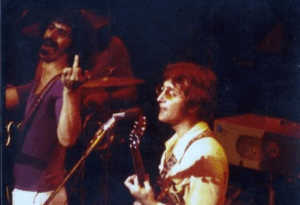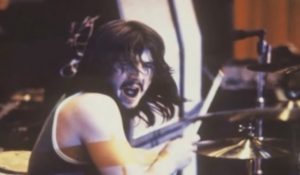The Story Behind Eddie Van Halen’s Signature Wolfgang Guitar

via Guitar World / Youtube
Eddie Van Halen is often remembered for wielding his iconic Frankenstrat. However, many overlook that this unique instrument only led his musical arsenal for six years, from 1977 to 1983. Yet, Eddie’s quest for the perfect sound didn’t end there. Throughout his prolific career, he employed a diverse array of guitars. Among these, the Wolfgang stands out, not just as another instrument, but as Eddie’s crowning achievement. Named after his son, the Wolfgang was more than a guitar; it was Eddie Van Halen’s vision brought to life, crafted with precision and care from the drawing board to the stage.
The Initial Step: Ernie Ball Music Man Version
The story of the Wolfgang began in the mid-’80s when Eddie Van Halen formed a partnership with Ernie Ball Strings. This collaboration, rooted in Eddie’s previous engagement with Kramer Guitars, soon evolved into the creation of a signature guitar. In 1991, the music world was introduced to the first iteration of the Wolfgang. This model showcased a fusion of design elements reminiscent of a Les Paul and a Telecasters, featuring a basswood body topped with flamed maple.
The guitar’s design focused on simplicity and efficiency. It was equipped with two DiMarzio-designed humbuckers, a single volume knob, and a pickup selector switch. Additionally, it boasted a Gotoh-licensed Floyd Rose tremolo system, setting a new standard for versatility and performance.
View this post on Instagram
Transition and Evolution: The Peavey Version
In 1996, Eddie’s partnership with Ernie Ball Music Man concluded. Though Ernie Ball Music Man continued to produce the Axis series, inspired by the Wolfgang, Eddie moved his expertise to Peavey. This transition marked a new chapter for the Wolfgang guitar. At Peavey, alongside experts Rich Lasner and Jim DeCola, Eddie refined the design of the Wolfgang, introducing enhancements that catered to both aesthetic and performance objectives.
Notably, the Peavey Wolfgang introduced a contoured maple top, differing from the flat top of its predecessor. Its basswood/maple composition remained, but the guitar’s shape evolved, offering a longer neck insertion into the body and a relocated horn. Also, the neck was reinforced with carbon fiber rods for added stability.
The redesigned headstock borrowed elements from the Gibson Flying V but was carefully modified to maintain a unique identity and avoid legal challenges. This version was rounded off with custom pickups, a tone control, and an improved Floyd Rose system, featuring a D-Tuner. Produced until 2004, the Peavey Wolfgang represented a significant phase in the evolution of Eddie Van Halen’s signature guitar.
The Final Iteration: The EVH Version
In 2007, Eddie began an exciting new collaboration with Fender, which led to the creation of a distinct entity: the EVH brand, encompassing guitars made and distributed by Fender. This venture signaled another transformation for the Wolfgang, as it received a comprehensive update.
This latest model showcased a fresh finish, pickups designed by Fender, Gotoh tuners, stainless steel frets, and high-quality hardware. These innovations not only enhanced the guitar’s appearance but also its performance. Eddie Van Halen wielded this version of the Wolfgang until his passing in 2020, marking the end of an era but leaving behind a legacy that continues to resonate with musicians around the world.











